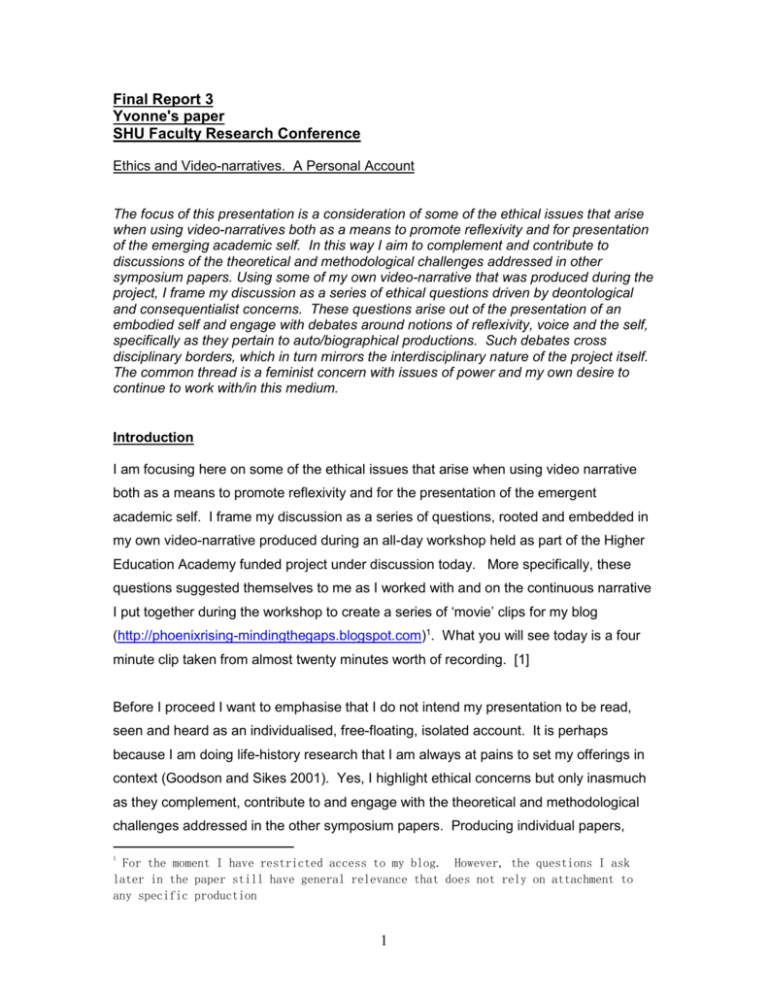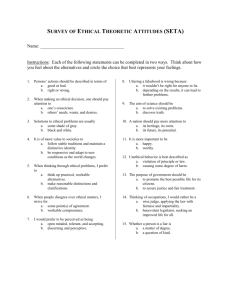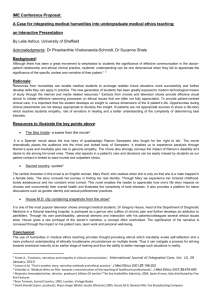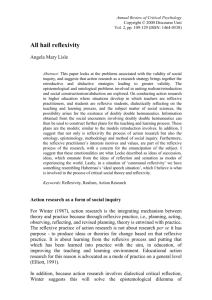Ethics and Video-narratives
advertisement

Final Report 3 Yvonne's paper SHU Faculty Research Conference Ethics and Video-narratives. A Personal Account The focus of this presentation is a consideration of some of the ethical issues that arise when using video-narratives both as a means to promote reflexivity and for presentation of the emerging academic self. In this way I aim to complement and contribute to discussions of the theoretical and methodological challenges addressed in other symposium papers. Using some of my own video-narrative that was produced during the project, I frame my discussion as a series of ethical questions driven by deontological and consequentialist concerns. These questions arise out of the presentation of an embodied self and engage with debates around notions of reflexivity, voice and the self, specifically as they pertain to auto/biographical productions. Such debates cross disciplinary borders, which in turn mirrors the interdisciplinary nature of the project itself. The common thread is a feminist concern with issues of power and my own desire to continue to work with/in this medium. Introduction I am focusing here on some of the ethical issues that arise when using video narrative both as a means to promote reflexivity and for the presentation of the emergent academic self. I frame my discussion as a series of questions, rooted and embedded in my own video-narrative produced during an all-day workshop held as part of the Higher Education Academy funded project under discussion today. More specifically, these questions suggested themselves to me as I worked with and on the continuous narrative I put together during the workshop to create a series of ‘movie’ clips for my blog (http://phoenixrising-mindingthegaps.blogspot.com)1. What you will see today is a four minute clip taken from almost twenty minutes worth of recording. [1] Before I proceed I want to emphasise that I do not intend my presentation to be read, seen and heard as an individualised, free-floating, isolated account. It is perhaps because I am doing life-history research that I am always at pains to set my offerings in context (Goodson and Sikes 2001). Yes, I highlight ethical concerns but only inasmuch as they complement, contribute to and engage with the theoretical and methodological challenges addressed in the other symposium papers. Producing individual papers, 1 For the moment I have restricted access to my blog. However, the questions I ask later in the paper still have general relevance that does not rely on attachment to any specific production 1 rather than one co-authored offering, is not synonymous with working in isolation. Yes, I was working alone with my particular video-narrative when these questions suggested themselves to me. But before this I had spent a day working intensively with other participants in the project, in the production of the videos and in informal and guided discussion of the issues that arose as part of that process. I had also spent around two hours with Carol Taylor, the lead researcher on the project, reflecting on my participation shortly after the all-day workshop. The questions I ask today are therefore steeped in and saturated with these encounters. Moreover, my interest in ethical issues as they pertain to narrative and specifically life-history research, is a long-standing one (Downs 2009) and this too informed my consideration of ethics in relation to video-narratives. [2] I am structuring my presentation as follows. Firstly I will give some contextual background to both the movie clip I am showing today and to the nature of the ethical questions that came up for me whilst I was working to produce it. Secondly I will present the questions prior to showing the clip of video-narrative I produced. Then I will show the video before finally returning to the questions in discussion with the audience. The structure I have chosen has been largely influenced by the parameters of this particular setting and I acknowledge it too will be influential in shaping what is said. [3] 1. Contextualising the movie clip My purpose in dividing my video-narrative into shorter ‘movies’ was to use some or all of these on my blog because during the workshop I realised that here was an opportunity of approaching the stated aims of my blog from a new angle. The reason I started my blog in the first place is connected to my research philosophy; to do feminist research with an ethical aim, a moral purpose and a reflexive impetus. I address the latter of these imperatives in a number of ways, such keeping a reflective journal, writing poetry, making a patchwork quilt and email correspondence with my supervisor and other PhD students. My blog is part of this reflexive impetus and is intended, as a means of ‘recording parts of my research journey other methods cannot reach’. To quote what I have posted (Downs 2008, unpaginated), I intended it to be firstly ‘a window on what I am willing to share/make public and what I want to keep private’, secondly a way to ‘trouble the academic habit of presenting a clever front’ and thirdly a test of my willingness to ‘ramble publicly’. My aims thus connect with debates around notions of 2 reflexivity, voice and the self, principally as they pertain to auto/biographical productions and, specifically, those auto/biographical productions connected to presentation of the emergent academic self. [4] Currently I have posted only one of the four movie clips I made. The absence of the others is due to issues of ‘internal confidentiality’ (Tolich 2004). That is, I refer to people I do not name but who would nevertheless be recognisable within certain circles. I thus have not yet resolved the conflicts and tensions between and within the various aspects of my research philosophy, specifically here between my commitment to reflexivity and to my ethical aims. Thus the questions that came up for me as I worked with my videonarrative were inflected by my work with my blog. It is for this reason that I am showing the movie clip ‘in context’, that is located within my blog rather than as a free-standing entity. As Pink (2007) reminds us, the visual cannot be divorced from other elements of culture and, furthermore, cultural artefacts and productions are also representations of social practices and experiences. [5] Such a view is consistent with my understanding of life history research but, nevertheless, I am aware that the ‘self’ I am presenting to you now is different to the one that would have been made known (revealed? created?) had the movie been shown out of context. This in itself is part of a wider ethical question which I will return to below. [6] 2. Contextualising the questions I must emphasise that, as well as being influenced by the context of my blog, the questions I am asking are also shaped by the ethical framework I have chosen, a framework constructed out of concerns that are deontological and consequentialist in nature. In other words the focus is on whether what is done or said does any immediate or lasting harm. A different ethical framework, for example one that was concerned with virtue ethics and notions of ‘doing good’ may well have yielded different questions. Another significant factor here is that I make claims to be a feminist researcher. Whilst this is both a contested and complex claim to make, for the purposes of this paper it is to be understood as a concern with issues of (specifically but not exclusively) gendered power in research. In this paper and within the ethical framework I have chosen these concerns are translated into broad questions of ‘what are we doing when we generate 3 accounts of experience, and what is it that we can responsibly do with those accounts?’ (Davies and Davies 2007:1140) [7] I am presenting the questions as interpolations of some of the arguments forwarded by Bev Skeggs (2002) in her critique of the telling of the ‘reflexive self’. This is a useful heuristic device here because Skeggs’ arguments concentrate not only on notions of reflexivity itself, but also on the ways it might be achieved, the uses to which it might be put in storying and stories of our ‘selves’ and the ethical implications of this. She thus works at the interface of reflexivity, narrative and ethics without conflating the three so her arguments enable me to cover a lot of ground without the need for lengthy explication. [8] These issues I isolate here are those I often turn to in my life history research and am reconsidering now in the light of having produced a visible, ‘text in motion’ (Davies and Davies 2007:1157). The questions are intended to be provocative and, because of the time constraints involved, designed to elicit discussion and engage the audience. Thus they are in no way intended to be prescriptive or comprehensive or to proscribe the ensuing discussion. Despite my presenting this section in table form, this is for ease of reading (I tried several formats) rather than to create boundaries or to impose a structure. This paper is but part of my ongoing engagement with these issues rather than a resolution of them. Hence there are no conclusions to this paper. It is performative rather than a performance, and, without forewarning you or obtaining your consent, I have envisaged a more active role for you as audience than is perhaps usual. The role of the audience is thus one of the questions also considered below. [9] 4 Questions of Ethics/Ethical Questions? Skeggs (2002) ‘The telling of personal stories operates as a form of rhetoric whereby we become seduced by the confession, the immediacy of the experience of being there and the personal information.’ (p364) ‘The techniques of telling also rely on accruing the stories of others in order to make them property for oneself’ (p349) ‘In order for some people to move, to be reflexive, others must be fixed in place’ (p349) ‘The telling of the self becomes a manifestation and maintenance of difference and distinction’ (p350) So we need only to ask who is representing themselves as reflexive, as having a self worth knowing, a voice worth hearing.’ (p365) ‘(The researcher’s) story is based on their identity which is usually articulated as a singularity and takes no account of movement in and out of space, cultural resources, place, bodies and others but nonetheless authorizes itself to speak’ (p360) ‘The discursive struggle has a long and dispersed history….The self that could be told also had to be seen to be fully known ….‘different technologies….enable different forms of narration and visuality.’ (p351) 5 Questions What are the seductions in operation here? How were they achieved? What purposes might such seductions serve? Does my narrative rely on this kind of appropriation? Can video-narrative provide the conditions for sidestepping this kind of appropriation? In what ways does using video re-define who is fixed and mobile? How much work is the audience required to do? What were the manoeuvres by which this was accomplished? Who am I representing here and is this a self that is authorised to speak? If so how is this achieved? To what extent does video facilitate my intention to present myself having multiple identities? Does this ‘text in motion’ (potentially) enable the movement to which Skeggs refers? To what extent can video be seen as breaking with this history? In what ways is it a more powerful instrument in the maintenance of (researcher) privilege and power? ‘(T)he powerful……authorize themselves through their own cultural resources’ (P363) ‘claiming reflexivity as a resource for authorizing oneself (p350)…mobilized for the display of cleverness’ (p351)…to shore up the composite of the academic reflexive self’ (p361) What techniques and manoeuvres have I used to authorise myself? My intention was not to display my ‘cleverness’. Did I avoid this and if not why not? 3. Viewing the video 4. Discussion Postscript I want to end by reminding readers that this paper must be seen as a very early attempt to grapple with some of the issues raised by Skeggs. I am by no means implying that I see the problematics of using video- narrative as insurmountable. Indeed I am increasingly interested in different ways of researching and representing research, particularly those that dissolve disciplinary boundaries and which reconfigure ‘social science’ as a creative enterprise and dissolve distinctions between creativity and so called intellectual endeavours. I am, as I state, also a determinedly reflexive practitioner. However, I also believe that part of our responsibility as scholars is to engage with arguments that shake us from our slumbers and require us to justify rather than merely state our positions. And this in itself is, I believe, a requirement of reflexivity itself. References Davies, B. and Davies C (2007) Having, and being had by ‘experience’: or ‘experience’ in the social sciences after the discursive/poststructuralist turn. Qualitative inquiry, 13(8), 1139-1159. Downs, Y. (2008) Old(ish) dog: new tricks. Blog post (online) available at http://phoenixrising-mindingthegaps.blogspot.com (accessed 28/05/09). Downs, Y. (2009) Ethics and narrative research: a contradiction in terms? In Robinson, D., Fisher, P., Yeadon-Lee, T., Robinson, S. J. and Woodcock, P. Narrative memory and identities Huddersfield: University of Huddersfield. 6 Goodson, I. and Sikes, P. (2001) Doing life history in educational settings: learning from lives. Buckingham: Open University. Pink, S. (2007) Doing Visual Ethnography (Second Edition). London: Sage Skeggs, B. (2002) Techniques for telling the reflexive self. In T. May (ed.) Qualitative research in action. London: Sage. Tolich, M. (2004) Internal confidentiality: when confidentiality assurances fail relational informants. Qualitative Sociology, 27(1), 101-106 Contact: Yvonne Downs, University of Sheffield Email: edp07yd@sheffield.ac.uk 7








